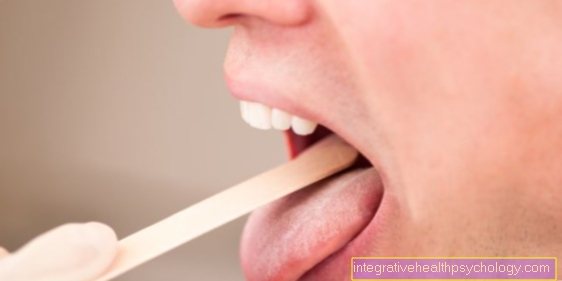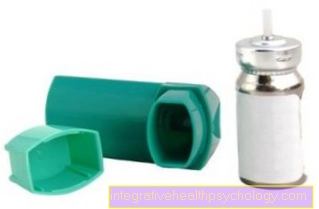Abscess on the roof of the mouth
definition
An abscess is a localized inflammation in which pus collects in a connective tissue capsule. An abscess can appear anywhere in the body. The oral cavity and thus the palate are no exception.
Most of the time abscesses are caused by the bacterium Staphylococcus aureus. Especially in the oral cavity, the mucous membrane has a lot of contact with the outside world and therefore also a lot of contact with possible germs. An abscess in the roof of the mouth can be very painful and also severely restrict speaking and chewing.
Read more on the topic: Inflammation in the mouth

root cause
In most cases, the triggering germ in an abscess is the Staphylococcus aureus. This occurs in about half of all people in the nasopharynx without causing discomfort. If the immune system is weakened, including a normal cold, the Staphylococcus aureus can lead to abscess formation. For this reason, chronically ill people and people who are immunocompromised by drugs are particularly often affected.
The germ is encapsulated and there is an accumulation of pus. The pathogen can also be transported to the palate via the blood from other parts of the body. Some other bacteria and fungi can also cause abscesses in rare cases.
Abscesses occur in the oral cavity, especially after dental operations, since the surgical wound creates a portal for the bacteria to enter. Damaged or dead teeth can also contribute to abscess formation. In some cases, multiple abscesses occur as the germ can spread through the bloodstream. In addition to bacterial abscesses, sterile abscesses can also occur. This is possible, for example, with a wisdom tooth that has not erupted. This leads to an accumulation of pus in the tissue without a germ migrating into the body region.
Read more on the topic: Abscess - causes, symptoms, treatment
therapy
The standard therapy for abscesses is surgical opening. The pus and destroyed tissue are removed and the area disinfected. A local anesthetic is placed beforehand to open the abscess cavity. A special feature in the oral cavity is the risk of pus getting into the respiratory tract, which is why it is often suctioned off here. The empty abscess cavity is then rinsed and, depending on the location, a tube is inserted, which continues to allow secretion to drain.
Read more on the topic: Operation of an abscess
Antibiotic therapy can also be useful for immunocompromised people, since the germ may be in the bloodstream and cause blood poisoning there. In the following days, those affected can also use a mouthwash to clean the operated area. If a local cause for the abscess can be found, for example a destroyed tooth, that cause should also be treated. After the abscess has been removed, food intake may initially be restricted and those affected should eat soft food.
Read more on the topic: Treatment of an abscess
Symptoms
An abscess is a local inflammation that is associated with the 5 classic inflammation symptoms in the affected area:
- pain
- Redness
- warming
- swelling
- Function restriction
In the case of complications, such as a broken abscess inwards, systemic symptoms can also occur. These include fever and a general feeling of weakness. In the case of abscesses in the palate that are far back, breathing may also be restricted.
pus
An abscess is always accompanied by the formation of pus. In the case of a Staphylococcus aureus infection, this pus is yellowish, creamy and odorless. Pus consists of submerged neutrophils. These are certain cells that are assigned to the body's immune system and are supposed to fight the bacterial infection. Pus in body cavities should always be removed, but in the case of abscesses this should always be done by a doctor and not carried out yourself.
Duration
After surgical removal, those affected still have pain, swallowing and speech problems for a few days and have to take care of the surgical wound. After a few days, the abscess cavity should heal and those affected should not have any symptoms.
Abscess on the palatal arch
The palatal arch is the arch in the back of the mouth with the uvula hanging in the middle. This area therefore has a lot of contact with environmental germs and other pathogens. Both food and inhaled air contain many foreign substances, all of which have to pass through the palatal arch. In contrast to the anterior palate, a dental cause is much rarer on the palatal arch, as the distance to the teeth of the upper jaw is greater.
An abscess on the palatal arch can be very painful and significantly impair breathing if the abscess extends far into the arch. In most cases, surgery is the necessary therapy for the abscess.
Abscess on the tonsils
Behind the anterior arch of the palate are the tonsils, which are mostly known from tonsillitis. The almonds are part of the human immune system and catch pathogens from food or the air. This task means that the tonsils intentionally have a lot of contact with germs. The barrier for the pathogen is significantly weaker than in other tissues.
If the immune system is now weakened, the Staphylococcus aureus can simply overcome the barrier and the body cannot fight it completely. Abscesses can form in the tonsils. These are just as painful as severe tonsillitis and severely restrict the swallowing process.
Groups of people in need of care should therefore always take a look down the throat if they have a loss of appetite. . One-sided swelling is noticeable during a throat check, since most tonsillitis affects both sides. Depending on the size of the abscess, either the abscess cavity can be emptied or the tonsil can be completely removed. Follow-up checks are required for a few days after the operation. Swallowing is pain-free again after a few days.





























